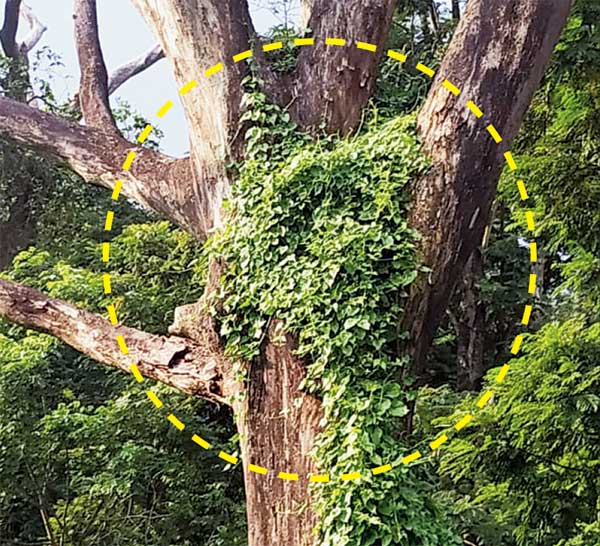Chinese manja or nylon kite strings are threatening plants and trees at the Indian Botanic Garden, Howrah.
Torn kites with manjas (strings laced with a mixture of glass and glue) can be seen trapped on the branches of practically all big trees at the over 300-year-old garden. Creepers and weeds can be found on these strings, covering the bark, branches and canopies of the trees depriving them of sunlight.
If left unchecked, such trees will die in a few years, a garden botanist said.
Such kite strings have left many two-wheeler riders and birds injured in the city.
The nylon strings, known as Chinese manja, are almost unbreakable and extremely sharp. These strings have left gardeners injured, too.
“Kites get caught in the branches of the tall trees and the manjas reach the ground. Often, creepers latch on to these manjas instead of growing horizontally along the ground,” Basant Kumar Singh, senior scientist, Botanical Survey of India, said.

Creepers (circled) on kite stings cover large tree trunks at the Indian Botanic Garden, Howrah Telegraph picture
“These weeds grow very quickly and send shoots down. In no time they cover the entire bark and branches of the tree and cover the canopy. If they continue to cover the canopy, the tree will die for want of sunshine and pollination.”
Most palm trees in the garden are covered by these creeper weeds. “Palms trees are particularly susceptible to such creepers because they do not branch. Other trees can branch and have a wide crown,” Singh said.
The garden is surrounded by human habitation along its three sides and the Hooghly to its south. The gradual rise in population pressure in the vicinity of the garden has affected the garden’s environment. Kites, usually flown by people living nearby, have been killing many rare species, according to garden officials.
In a publication titled, “Flying kites: A threat to conservation of plants in AJC Bose Indian Botanic Garden” in the Indian Journal of Biological Sciences, Singh, along with C.M. Sabapathy and Arabinda Pramanik, wrote: “The abandoned trapped kites on tree tops with long hanging strings act as an excellent primary climbing support for tender climbers, giving easy passage to reach even the top of tall trees.
“Later, production of lateral branches from the top of the climber and other accessory branches, and even other climbers from the ground reaching the top taking support of the first climber, completely cover the tree top.
“This reduces the assimilation rate of the trees and reduces the growth rate. It hampers pollination by suppressing the exposure of flowers to the pollinator and competing for nectar content.”
There are 151 climbing plant species in the garden. Of these, 15 climbers were recorded to cause damage to trees. These climbers need support to climb according to their physiological requirement.
Trees with smooth and stout stems rarely provide such climbers with support. But kite strings hanging from tree tops provide an ideal support to the climbers for easy anchoring and twisting around.
In seven of 10 such instances, these weeds reach the canopy of other trees because of kite strings. These strings harm birds, too. Many have been found trapped by such strings, an official said.











